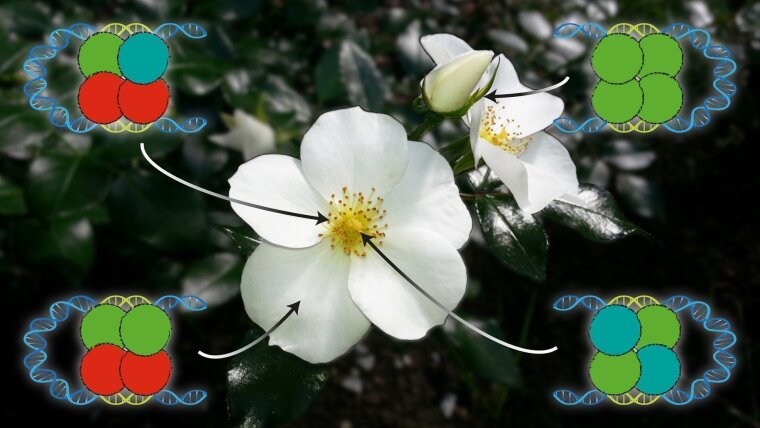
Overview
Flower development is controlled by hierarchically organized networks of genes, many of which encode MIKC-type MADS-domain transcription factors. Changes in these regulatory networks are underlying the morphological evolution of flowers and hence the generation of floral biodiversity. The interactions between floral developmental control genes have so far mainly been defined genetically. However, to better understand the molecular evolutionary dynamics of the gene regulatory networks, their 'hard-wiring' has to be determined, i.e. the physico-chemical interactions on which network topology is based. Especially important are the protein-protein interactions that generate trans-acting transcription factor complexes, and the specific binding of theses complexes to cis-regulatory DNA sequences of target genes. Of central interest are the floral homeotic proteins, which form multimeric complexes ('floral quartets') specifying floral organ identity by activating and repressing appropriate target genes during the development of floral organs. Almost all of them are MIKC-type proteins. We have developed a hypothesis that links the evolutionary importance of MIKC-type proteins via their unprecedented capacity to form different heteromultimers of homologous proteins and hence to achieve target gene specificity to their unique domain structure (Kaufmann et al., 2005). We are testing this hypothesis by studying protein-protein and protein-DNA interactions of MIKC-type proteins from phylogenetically informative seed plants as well as the interaction capabilities of closely related MIKC-type proteins from non-seed plants such as lycophytes, ferns and mosses. Techniques used are yeast-n-hybrid-analyses, gel retardation assays, and coimmunoprecipitation assays.
-
Grants
From 2006 to 2008, Rainer Melzer was funded by the Studienstiftung des deutschen Volkes.
From 2009 to 2015 this project was supported by the DFG (Deutsche Forschungsgemeinschaft) grants TH 417/5-1, TH 417/5-2, and TH 417/5-3.
From 2010 to 2013 Rainer Melzer was funded by the Carl-Zeiss-Stiftung.
From 2013 to 2016 Sandra Gusewski was funded by the International Leibniz Research School (ILRS). -
Suggested Reading
Käppel, S., Melzer, R., Rümpler, F., Gafert, C., & Theißen, G. (2018).
The floral homeotic protein SEPALLATA 3 recognizes target DNA sequences by shape readout involving a conserved arginine residue in the MADS‐domain.
The Plant Journal, 95(2), 341-357External linkRümpler, F., Theißen, G., & Melzer, R. (2018).
A conserved leucine zipper-like motif accounts for strong tetramerization capabilities of SEPALLATA-like MADS-domain transcription factors.
Journal of experimental botany, 69(8), 1943-1954External linkTheißen, G., Melzer, R., & Rümpler, F. (2016).
MADS-domain transcription factors and the floral quartet model of flower development: linking plant development and evolution.
Development, 143(18), 3259-3271External linkMelzer, R., Härter, A., Rümpler, F., Kim, S., Soltis, P. S., Soltis, D. E., & Theißen, G. (2014).
DEF-and GLO-like proteins may have lost most of their interaction partners during angiosperm evolution.
Annals of botany, 114(7), 1431-1443External linkMelzer, R., Verelst, W., & Theißen, G. (2009). The class E floral homeotic protein SEPALLATA3 is sufficient to loop DNA in ‘floral quartet’-like complexes in vitro. Nucleic Acids Research, 37(1), 144-157External link
Kaufmann, K., Melzer, R. and Theißen G. (2005).
MIKC-type MADS-domain proteins: structural modularity, protein interactions and network evolution in land plants.
Gene 347, 183 - 198External link